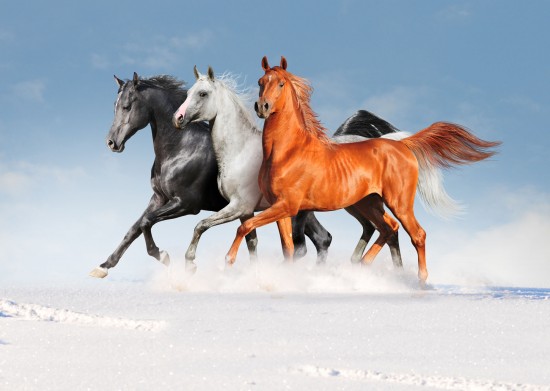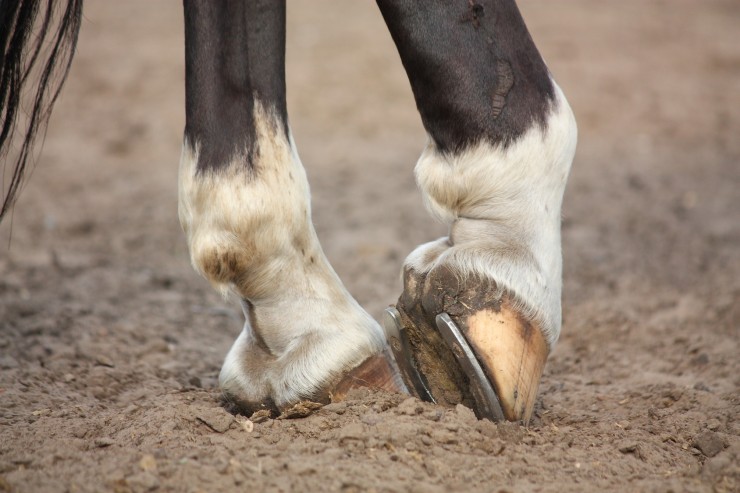
Whether you抳e got a pony for the kids, or a full-blooded Arabian, getting the animal to do what you want and need it to do is the most important thing for all concerned. An untrained horse makes for an unsafe horse, and an unsafe horse makes for unhappy owners. Ideally, training should begin as soon as possible, but if you aren抰 able to begin training your horse until it is older, don抰 despair. You can still have a well-behaved, well-mannered, rideable horse.
Begin by simply letting your horse know that you aren抰 afraid of it or nervous around it. Appearing calm and decisive will go a long way to gaining your horse抯 trust and confidence. Simply walk around the corral or pen, or walk through the stable, as if it were the most natural thing in the world for you to do. Check the feed and water troughs or buckets. Get your horse used to seeing you in his space. He will soon come to accept that you share his world and that you are alright to have around. Don抰 try to catch or even touch the horse unless he approaches you. If you抳e got a friendly horse, he抣l take to you easier and sooner than one who is suspicious or skittish of people.
After your horse is used to having you around, you can begin training. One of the most important things you can train your horse to do is to walk beside you on a lead. In order to train to a lead, your horse has to be used to wearing a halter. If he isn抰 halter trained, start out slow and small. Spend 15 minutes holding it in front of him, letting him sniff and even taste the halter. Once he gets used to the sight of the halter in front of him, move it over his head. Just hold the halter above him ?don抰 try to put it on yet. He may shy away at first, but he抣l get used to it soon enough. Again, work for 15 minutes or so at a time. Never train your horse past his tolerance level. Tired or frustrated horses don抰 learn anything, and depending on their personalities, can become dangerous when fatigued or bored. Once your horse is accustomed to seeing you with the halter near his head, put it on. You may only get it over his nose the first few times and that抯 alright. Again, he抯 got to become comfortable with the idea, as well as the item, that you are presenting. Once he gets it on, only leave the halter on for 10 to 15 minutes at a time for the first few times. He may try to toss his head or rub or paw at the halter. Once he becomes comfortable with the halter on, then you can leave it on if you choose. Coming at a horse with a halter, slamming it over his head and then forcing him to wear it can build an attitude of resentment toward you, and an atmosphere of mistrust on the part of your horse. Slow and steady training, with careful, calm voice and movements, will win over rough or rowdy any day.
The next step is lead training. This is best done with a long lead. As with the halter, take things slow and easy. Let the horse sniff the lead before you use it. Clip it to his halter and let it hang down, so he can feel the weight of it. Try to get him to walk toward you without pulling on the lead to start. Do this with a favorite treat or a handful of hay. Once he begins to step toward you, tighten the lead so that he acquaints the tug of the lead with moving. Stop after 15 to 20 minutes. Once he is comfortable walking with the lead, come back beside him. Take a step and tug the lead. Take another step and tug again. He will quickly learn that he walks when you walk. If he doesn抰 like to stop when you stop, try placing your hand in front of his nose and tugging the lead backward. You can add a verbal command if you like, but it is not necessary.
Your horse will need to learn to tolerate being touched all over. Certain body areas are more sensitive than others and horses will naturally shy or become defensive when touched in those areas. Start by giving a positive, pleasing touch with on hand while the other hand moves to an area of discomfort. The horse will soon get used to the feel of a hand on his ear, muzzle or chest and will no longer bite, kick or shy away. He抣l learn to trust you with his body, making vet care, hoof care, grooming, as well as saddle training and other types of training easier and more pleasant for all involved.
Poorly trained horses will often pull or whinny and fuss when tied. One way to train a horse to stand quietly while tied is to first just stand beside him and not move. He抣l most likely be used to walking beside you. Standing still may confuse him at first, but he抣l get used to it. Move on to tying the lead, but still standing beside him. Next, stand a little farther away, so that he can see you but not so far away that you can抰 reach out and reassure him or stop him if he becomes upset or tries to move. Once he remains calm after you move away, walk out of his sight for just a moment or two. Gradually build this to longer and longer periods of time. Your horse will soon quietly, waiting patiently for you to return. Standing quietly will also help you when it comes to grooming, cleaning hooves, or administering medical treatment.
Getting him walking beside you, allowing himself to be touched, and standing quietly are perhaps the three most important things you can teach your horse. Even if he is only ever going to serve as a pasture ornament, walking on a lead, tolerating touch, and standing still make vet care, grooming and other necessities of horse ownership so much easier and stress-free for both horse and master. Always remember to allow your horse to become accustomed to any new idea or item slowly, calmly, and for short amounts of time to start. You may never take the stakes, but a well-trained horse is a winner, hands down!
 Extraordinary Colours & Characteristics Of The Arabian Horse
Extraordinary Col
Extraordinary Colours & Characteristics Of The Arabian Horse
Extraordinary Col
 How To Find/buy Healthy Pet Rats
How To Find/buy H
How To Find/buy Healthy Pet Rats
How To Find/buy H
 How To Deal With Thrush In Horses
How To Deal With
How To Deal With Thrush In Horses
How To Deal With
 Responsible Factors For Shih Tzu Allergies
Responsible Factors For Shih Tzu Allergies
Shi
Responsible Factors For Shih Tzu Allergies
Responsible Factors For Shih Tzu Allergies
Shi
 Are Cats Better At Letting You Know They Are Sick Than Dogs?
Are Cats Better A
Are Cats Better At Letting You Know They Are Sick Than Dogs?
Are Cats Better A
Copyright © 2005-2016 Pet Information All Rights Reserved
Contact us: www162date@outlook.com